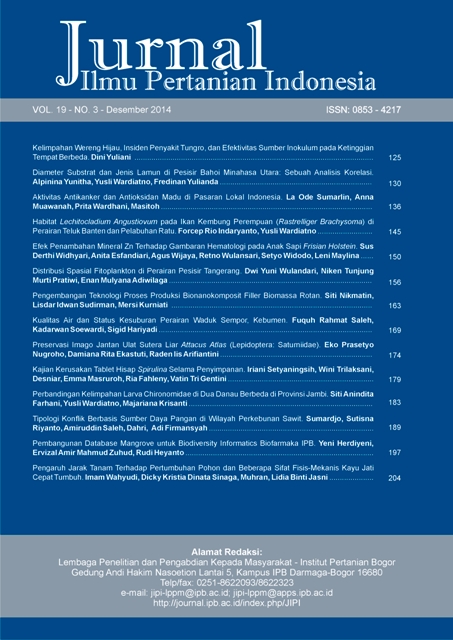Kelimpahan Wereng Hijau, Insiden Penyakit Tungro, dan Efektivitas Sumber Inokulum pada Ketinggian Tempat Berbeda
Abstract
Rice Tungro disease is one of biotic constraint that can reduce yield potential of rice. Tungro disease viruses are transmitted from one plant to another by leafhoppers that feed on tungro-infected plants. The most efficient vector is the green leafhopper, Nephotettix virescens. Green leafhoppers (GLH) generally found in areas with high altitude and low temperature. However, GLH and tungro disease can be found in medium and low altitude areas. The aim of this study was to determine the abundance of green leafhopper, tungro disease incidence, and effectiveness of inoculum source in different altitude at endemic areas. Field observations conducted to observe tungro disease incidence and the density of GLH population. Moreover, greenhouse activities were conducted to examine the effectiveness of inoculum sources, including ratoon, spilled grain, weeds, and plants in the vegetative phase. The results showed there was no significant difference in the GLH population dynamics in upland areas represented by Garut and lowland areas represented by Purwakarta, both showed low population density. Ratoon, spilled grain, and plants in the vegetative phase were the effective inoculum sources to be used as host tungro viruses.
Downloads
References
Chancellor TCB, Cook AG, Heong KL. 1996. The within-field dynamics of rice tungro disease in relation to abundance of its major leafhopper vectors. Crop Protection. 15(5): 439-449.
Chancellor TCB, Holt J. 2008. Tungro disease dynamics. In: Rice tungro virus disease: a paradigm in disease management. ER Tiongco, ER Angeles and LS Sebastian (ed). p. 92-115. Science city of Munoz, Nueva Ecija: Phillipine Rice Research Institute and Chiba (JP): Honda Research Institute.
Gomez KA, Gomez AA. 1984. Statistical Procedures for Agricultural Research. Second Edition. John Wiley & Sons. Inc. Canada.
Hasanuddin A, Koesnang, Baco D. 1997. Rice tungro disease in Indonesia; present status and current management strategy. In: Chancellor TCB, Thresh JM. (eds.). Epidemiology and Management of Rice Tungro Disease. Chatam (GB): National Resource Institute.
Hasanuddin A. 2009. Status tungro di Indonesia Penelitian dan Strategi Pengelolaan ke Depan. Disampaikan pada orasi purnabakti Puslitbangtan, Bogor 31 Maret 2009.
Hibino H, Roechan M, Sudarisman S. 1978. Association of two types of virus particles with penyakit habang (tungro disease) of rice in Indonesia. Phytopathology. 68(10): 1412-1416.
Hibino H, Cabunagan RC. 1986. Rice tungro associated viruses and their relation to host plants and vector leafhopper. Tropical Agriculture Research Series. 19: 173-182.
Hibino H. 1996. Biology and epidemiology of rice viruses. Annual Review of Phytopathology. 34(1): 249-274.
Kusdiaman D, Widiarta IN. 2003. Pengaruh faktor intrinsik dan lingkungan terhadap aktivitas pemencaran wereng hijau. Jurnal Agrikultura. 14(1): 22-29.
Narayanasamy P. 1972. Influence of age of rice plant at the time of inoculation on the recovery of tungro virus by Nephotettix impicticeps. Journal of Phytopathology. 74(2): 109-114.
Raga IN, Murdiata W, Tri MPL, Edy SW, Suherman O. 2004. Sistem surveilance antisipasi ledakan penyakit tungro di Indonesia. Prosiding Seminar Nasional Status Program Penelitian Tungro Mendukung Keberlanjutan Produksi Padi Nasional. Puslitbang Tanaman pangan. Balitbang Pertanian. Hal 49-59.
Raga IN. 2007. Perkembangan dan Penyebaran Penyakit Tungro di Indonesia. Prosiding Seminar Nasional “Strategi Pengendalian Penyakit Tungro Mendukung Peningkatan Produksi Beras”. Makassar, 7-8 September 2007.
Suzuki YI, Widrawan KR, Gede IGN, Raga IN, Yasis, Suroto. 1992. Field epidemiology and forecasting technology of rice tungro. Disease vector by green leafhopper. Japan Agricultural Research Quarterly. 26: 98-104.
Widiarta IN, Yulianto, Muhsin M. 1997. Status penyebaran penyakit tungro pada padi di Jawa Barat. Jurnal Perlindungan Tanaman Indonesia. 3(1): 23-31.
Widiarta IN, Kusdiaman D, Aryawan IGN. 1999. Study on dispersal activity of Nephotettix virescens Distant, the most effective vector of rice tungro virus disease. One day seminar ITSF. Jakarta (ID), 31 january 1999.
Widiarta IN, Kusdiaman D, Koesnang. 2001. Fenomena dan faktor yang memengaruhi pergeseran dominasi dan komposisi spesies wereng hijau (Nephotettix spp.). seminar Nasional Perhimpunan Entomologi Indonesia. Bogor (ID), 6 November 2001. p. 15-20.
Widiarta IN. 2002. Strategi pengendalian penyakit tungro pada ekosistem pertanaman tidak serempak dari segi dinamika populasi. Jurnal Fitopatologi Indonesia. 6(1): 6-11.
Widiarta IN. 2005. Wereng hijau (Nephotettix virescens Distant): Dinamika populasi dan strategi pengendaliannya sebagai vektor penyakit tungro. Jurnal Litbang Pertanian. 24(3): 85-92.
This journal is published under the terms of the Creative Commons Attribution-NonCommercial 4.0 International License. Authors who publish with this journal agree to the following terms: Authors retain copyright and grant the journal right of first publication with the work simultaneously licensed under a Creative Commons Attribution-NonCommercial 4.0 International License. Attribution — You must give appropriate credit, provide a link to the license, and indicate if changes were made. You may do so in any reasonable manner, but not in any way that suggests the licensor endorses you or your use. NonCommercial — You may not use the material for commercial purposes.



















